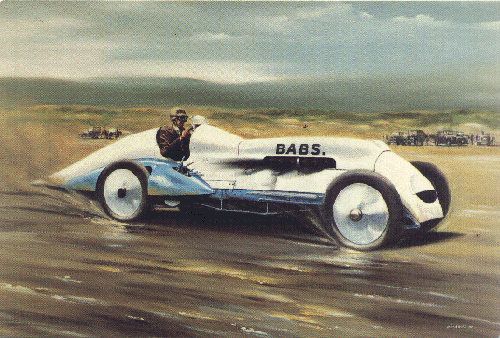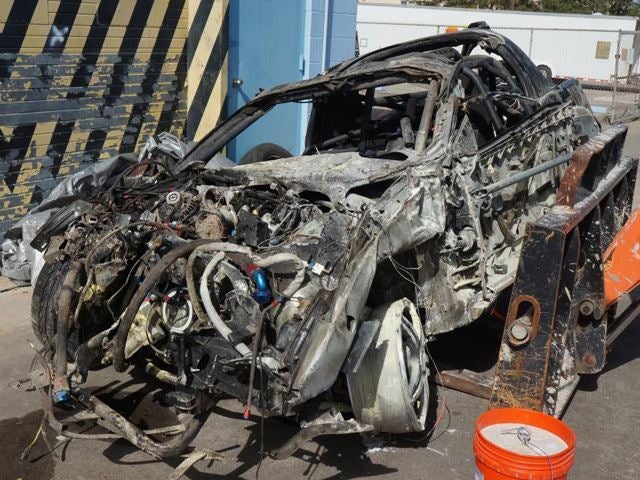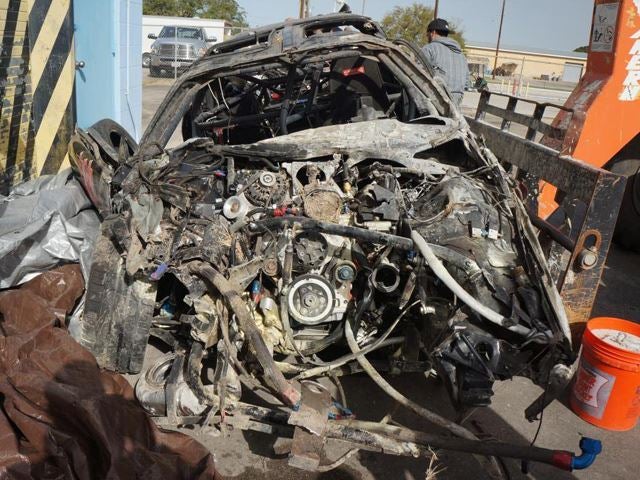 "Jonny Edge (@thejonnyedge)" (thejonnyedge)
"Jonny Edge (@thejonnyedge)" (thejonnyedge)
03/03/2014 at 10:39 • Filed to: HISTORY, LAND SPEED RECORD, WALES
 1
1
 3
3
 "Jonny Edge (@thejonnyedge)" (thejonnyedge)
"Jonny Edge (@thejonnyedge)" (thejonnyedge)
03/03/2014 at 10:39 • Filed to: HISTORY, LAND SPEED RECORD, WALES |  1 1
|  3 3 |

87 years ago today, J.G Parry-Thomas was killed attempting to take back the land speed record wrestled away from him just weeks earlier by the famous Malcolm Campbell. Pendine Sands was the location of this event and it was to play a big part in the story of the machine dubbed 'Babs' for many years to come, unbeknownst to its pilot.
Parry-Thomas first achieved a new world record for land speed in April of 1926, smashing the existing record by around 20mph as he set a new time of 171mph. When I think about it, the fastest I have ever been zooming along in a cosy, safe and well designed modern car is a mere 135mph. So imagine then travelling 171mph in a primitive car powered by a twelve cylinder aeroplane engine... on a damp beach. It must have required gargantuan levels of manliness to do such a thing.
That 'primitive car' was named 'Babs' by Parry-Thomas when he purchased the undeveloped car for the sum of £125 (around £3,800 in 2005's currency) in 1924. That beastly V12 had a capacity of 27l and was said to develop around 450bhp. To the average person in 1926, 450bhp must have been an absolutely astonishing figure. Parry-Thomas re-engineered some carburetors and pistons, and then went out to Pendine Sands and smashed the world land speed record with it in April '26.
When his rival and the more famous Malcolm Campbell beat Parry-Thomas's record in February of 1927 by a tiny 3mph, Parry-Thomas decided to go out once again to try and reclaim his record on March 3rd 1927. Unfortunately, it was to be his final act. Parry-Thomas suffered a mechanical failure of some sort and the car flipped and rolled down the beach at around 100mph, he was killed in the accident.
Parry-Thomas was buried in Surrey, England, and in a somewhat symbolical move, 'Babs' was buried on Pendine Sands and it was there she remained until remarkably being dug up and restored over two decades by local engineer and lecturer Owen Wyn Owen. Amazingly the car was successfully restored despite remaining under the sand for decades. Now in running order, 'Babs' is now displayed in the Pendine Museum of Speed, just a short distance from where Parry-Thomas and his girl made their final, fatal record attempt.
It's here where I end this little write up, I wanted to make a nice short piece to spike some curiosity amongst my fellow members of Oppo. If you plan on driving quickly at any point today, before you turn the key stop and think for a moment about J.G Parry-Thomas. A stupendously brave man who was killed on this day pioneering the performance automobile. If you happen to pass Pendine Sands anytime, go and pay old 'Babs' a visit, and imagine her taking you to 171mph on a damp beach in chilly Wales. Incredible. I'll leave you now with a link to a far better written piece about the man, this event, and the characters and places in it.
The Website to check out if your curiosity has been spiked by my ramblings:
!!!error: Indecipherable SUB-paragraph formatting!!! - Owned by his family to the day. This covers just about everything you'll ever need to know about the story of J.G Parry-Thomas. Incredible website.
 Gizmo - The Only Good Gremlin, but don't feed me after Midnight
> Jonny Edge (@thejonnyedge)
Gizmo - The Only Good Gremlin, but don't feed me after Midnight
> Jonny Edge (@thejonnyedge)
03/03/2014 at 17:39 |
|
Well Done! I, too, am an addicted Land Speed Racer. Knowing the history of the sport is important, even for us slow guys.
I run street legal, stock block, under 5L with a goal of 170MPH in the standing mile. Since I hold two records currently, I'll wait till my time is beat before going back out again. Fun sport, but high risk. I've had my own share of sheer terror in racing incidents and at these speeds, talent and luck can only get you so far. Luckily, with most sanctioned events, the safety requirements have significantly improved our chances of surviving most incidents.
Here's a video of the words fastest Camaro having a bad spill at 200+. Thankfully, the driver Joey Huneycutt escaped the high-speed crash with only minor injuries but the Camaro on the other hand wasn't so lucky. Had to airlift the driver, but he did survive. I was there and it scared me as a spectator.
The car was completely destroyed but check out the cabin area - still mostly intact.


 Jonny Edge (@thejonnyedge)
> Gizmo - The Only Good Gremlin, but don't feed me after Midnight
Jonny Edge (@thejonnyedge)
> Gizmo - The Only Good Gremlin, but don't feed me after Midnight
03/03/2014 at 18:24 |
|
Gizmo, thank you so much for posting this. It's awesome. You hold 2 records? That's seriously cool, congratulations on getting them! (I might be a bit late, but congrats anyway!)
I find it absolutely remarkable that Parry-Thomas and other pioneers back in the day did this, it must have taken phenomenal bravery to attempt such a thing. I honestly don't think I'd be up for doing it in modern cars, so a tip of the cap to you for getting out there and doing it. I think there's a solid gold article in there just waiting to come out by the way!
Do you have any clue as to the accidents to runs ratio or anything? Do you think much about the safety side or is that something as a racer you put to the back of your mind?
 Gizmo - The Only Good Gremlin, but don't feed me after Midnight
> Jonny Edge (@thejonnyedge)
Gizmo - The Only Good Gremlin, but don't feed me after Midnight
> Jonny Edge (@thejonnyedge)
03/04/2014 at 01:19 |
|
My hat's off to all the pioneers of the sport, anything before the '80s must have been death defying and many didn't make it. I did a brief recap of my last incident here: LSR Season Is About to Begin. Should I Go, Or Should I Stay... Not a 'solid gold' article by any means but an intro of LSR and the mentality of LSR drivers to the group.
!!! UNKNOWN CONTENT TYPE !!!
Most folks don't bother with those kind of statistics out of reverence for the aforementioned pioneers of the sport, but of all the races I've attended, I would guess the average is one car/bike totaled for every 500 runs (standing mile averages 350 runs per race weekend); one incident every 50 runs (from blown motors to fires, loss of traction, loss of brakes, etc.)
Your safety question doesn't have a short or simple answer. Again reference my above link. This would probably make a great OPPO article filled with many laughable anecdotes. The quick synopsis is most of us build our own cars and select our own personal safety equipment. The cars are built to at least the minimum of the sanctioning body's safety specs. So from the time someone decides to get involved to the time you drive the car up to the start line, it's all about getting the fastest car, motorcycle, etc. that you are comfortable (which means to me: safely) piloting within the rules. Inevitably, stuff happens! I, and many others have our last safety checks written somewhere in the cockpit because on the line adrenaline takes over and only with repetition and assistance will I remember the last few things I need to do before putting my foot through the floor for the next 30 seconds. From the start line to the turnoff after the finish all you can do is trust your training, instincts, and equipment.
Keep in mind this is a different kind of racing. There is no trophy for winning, no purse for finishing on top, unless you're at the highest echelon it's at best all about bragging rights (and the highest echelon is just another level of bragging rights). Most of the veterans all know each other, and if one team needs a hand, everybody is willing to pitch in to get him/her back to that start line. And any loss of life is losing a family member.